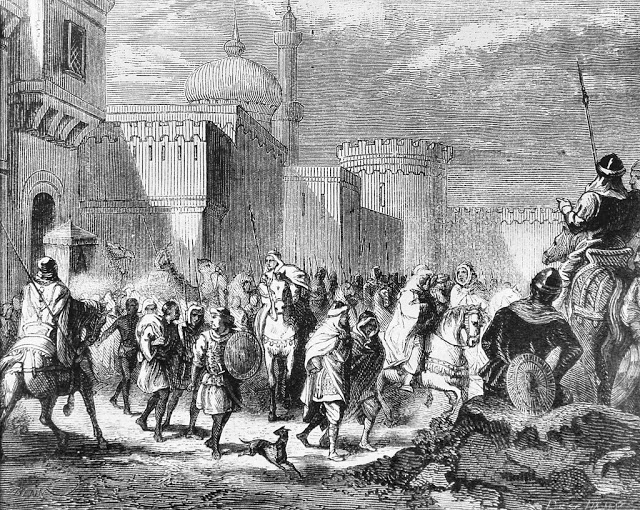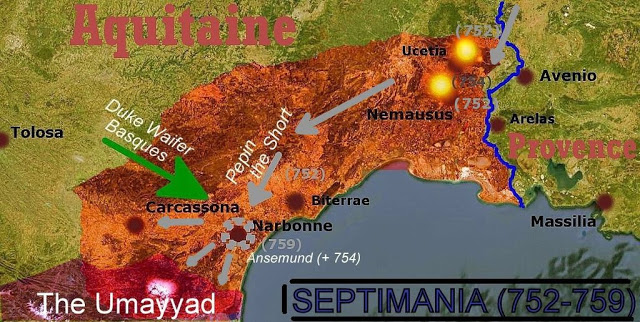Medieval History
- Vasconia, Independent With Aquitaine (660-769)
The Basques were brought to heel in 635 after a gigantic Franco-Burgundian expedition. The Basque leaders vowed loyalty to Frankish king Dagobert I, but after his death the Merovingian dynasty sank in a steady decline started with the so-called rois...
- Vasconia: Early Merovingian Period (602-660)
Prehistoric megalithic monuments like this, mainly dolmens and cromlechs, were important landmarks erected at crossroads and mountain passes. Still in the Early Medieval Ages, representatives of neighbouring tribes and valleys honoured their ancestors...
- The Duchy Of Vasconia: Extent And Organization
The Duchy of Vasconia (or Wasconia) was initially (AD 602) a polity created by the Franks aimed at holding sway over the Basques. The first dukes appointed were of Germanic stock, but Vasconia was far away from the Frankish heartland and despite its suzerainty...
- Catching Up On Some Posts
The following (or in this case I suppose are preceding) are catch up posts: LAST CALL FOR PAPERS The End of the Visigothic Kingdom of Toulouse, the Rise of the Franks, and the 'Beginning of France': A Symposium on the Occasion of the 1500th Anniversary...
- Imperial Rome Part 2: Ostrogoths And Visigoths- The Ancient Germans And An Expanding Rome
My other blogs are:http://religion-by-kyle.blogspot.comhttp://astronomy-by-kyle.blogspot.comOstrogoths and Visigoths The Ancient Germans and a Troubled Rome Imperial Rome Part 2The Goths of 5th and 6th centuries A.D. We've all heard of them, no doubt....
Medieval History
Siege of Narbonne (752-759)
The Siege of Narbonne took place between 752 and 759 led by the Frankish king Pepin the Short against the Muslim stronghold defended by an Umayyad garrison and its Gothic and Gallo-Roman inhabitants. The siege remained as a key battlefield in the context of the Carolingian expedition south to Provence and Septimania starting in 752. The latter was up to that point in the hands of the Muslim Umayyad and the local nobility of Gothic and Gallo-Roman stock, who had concluded with the Muslims different military and political arrangements to oppose the expanding Frankish rule.
 |
| Muslims leaving Narbonne in 759 after 40 years |
APPROACHES
Septimania's and Provence's legal system was not the Frankish, but they ruled themselves according to the Gothic and Gallo-Roman law respectively. In 752, after obtaining the Pope´s recognition and the dignity of King of the Franks and deposing the last Merovingian king, Pepin the Short felt free to focus all his might on subduing the Septimania and Provence. Previously his father Charles Martel failed to conquer the above regions in 737, and left a deep scar of devastation on various cities that had failed to support him.
However, while the Gothic magnates didn´t support the Franks formerly, things were changing this time: Nîmes, Agde and Béziers were handed over to him by the Gothic count Ansemund. Mauguio surrendered too. Count Miló was at the time ruling in Narbonne as a vassal of the Umayyad, but when Ansemund handed over several cities to Pepin, Miló didn´t join, probably deterred by the strong Muslim garrison stationed in the city.
START OF THE SIEGE
The Frankish king Pepin lay finally siege to the Gothic Muslim Narbonne in 752 with a view to seizing it with no delay. The regions of present-day Catalonia and Septimania were affected by famine after 750, and weakened by the shortage. However, Pepin suffered a major blow when his main local, Gothic ally Ansemund was killed by a rival Gothic faction during the besieging operations in 754. The death of the count was followed by a revolt in Nîmes that was put down by Pepin, and a Frankish governor imposed. Furthermore, the Aquitanian rival duke Waifer is recorded at the beginning of the decade as leading an army of Basques against the rearguard of the Carolingian king on his siege of Narbonne. The Narbonnese garrison and residents were able to withstand Pepin´s siege thanks to the supplies provided by sea by the Umayyad navy.


CONQUEST OF NARBONNE
In 759, Narbonne wasn´t receiving reinforcements from Al-Andalus, rife as it was with internal fights. Finally, the defenders of Narbonne (made up of Muslims and non-Muslims alike) surrendered to the Frankish forces after killing the Umayyad garrison and opening the gates of the stronghold to the investing forces of the Carolingian king. Previously, the king Pepin had promised to uphold and respect the Gothic laws and probably their own government, so garnering the allegiance of the Gothic nobility of Septimania.
AFTERMATH
After the conquest of Narbonne, the Umayyad retreated to their Andalusian heartland, and the Carolingian king Pepin came up reinforced. The government of the city was assigned to the Visigothic count Miló, who had fled the city 5 years before when it was being besieged and had retreated to Trausse. The submission of Septimania and the allegiance of its Visigoth nobility allowed the Frankish leader to divert now his attention to his only internal opponent, the independent duke of Aquitaine Waifer, who now could count the Septimanian Goths out as allies. On the wake of Narbonne´s submission, Pepin took Roussillon, and immediately after directed his effort against Toulouse, Rouergue, Albigeois in Aquitaine that was heralding the battle for Aquitaine.
- Vasconia, Independent With Aquitaine (660-769)
The Basques were brought to heel in 635 after a gigantic Franco-Burgundian expedition. The Basque leaders vowed loyalty to Frankish king Dagobert I, but after his death the Merovingian dynasty sank in a steady decline started with the so-called rois...
- Vasconia: Early Merovingian Period (602-660)
Prehistoric megalithic monuments like this, mainly dolmens and cromlechs, were important landmarks erected at crossroads and mountain passes. Still in the Early Medieval Ages, representatives of neighbouring tribes and valleys honoured their ancestors...
- The Duchy Of Vasconia: Extent And Organization
The Duchy of Vasconia (or Wasconia) was initially (AD 602) a polity created by the Franks aimed at holding sway over the Basques. The first dukes appointed were of Germanic stock, but Vasconia was far away from the Frankish heartland and despite its suzerainty...
- Catching Up On Some Posts
The following (or in this case I suppose are preceding) are catch up posts: LAST CALL FOR PAPERS The End of the Visigothic Kingdom of Toulouse, the Rise of the Franks, and the 'Beginning of France': A Symposium on the Occasion of the 1500th Anniversary...
- Imperial Rome Part 2: Ostrogoths And Visigoths- The Ancient Germans And An Expanding Rome
My other blogs are:http://religion-by-kyle.blogspot.comhttp://astronomy-by-kyle.blogspot.comOstrogoths and Visigoths The Ancient Germans and a Troubled Rome Imperial Rome Part 2The Goths of 5th and 6th centuries A.D. We've all heard of them, no doubt....
.
